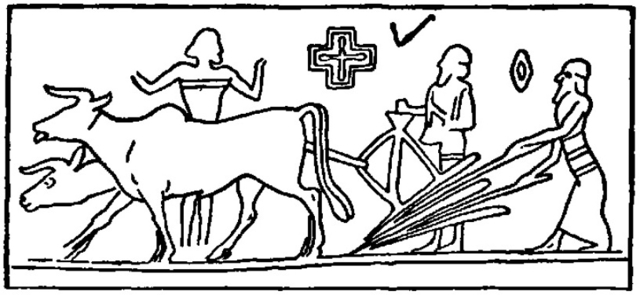
| KASSI (KASHI) AS HITTITES 4. Kassi (Kashi) as Hittites :
According to Lieutenant Colonel Laurence Austine Waddell :
The
Makers of Civilization in Race and History :
This location in Hittite Asia Minor in south-east Cappadocia for the Kassi homeland is confirmed by an inscription of a Kassi sailor prince who has left an inscribed monument in the Don Valley of Scotland about 400 B.C., as I have fully described and figured elsewhere. In his bilingual inscription with the Sun-Cross he tells that he erected his great stone monument to the fire-god Bil, and in it he calls himself by all four titles of Phoenician, "Hittite," Barat and Kazzi or Qaz, and that he came from the city of Kast in Cilicia.
This Kast, I have shown, was the old Sun-temple city of Kasta-bala on the upper Pyramus River, near its head-waters on the border of south-east Cappadocia, and is on the border of this old Hittite provincial city-state of Kishshia or Gashshia. We shall also find that the Kassi language has affinities with the Hittite and other Aryan or Indo-European languages.
Early
relations of the Kassi with Babylonia :
FIG. 71 C. : Kassi or "Cassi" ploughing and sowing under the Sign of the Cross. From a Kassi official seal of 1400 B.C. (After Clay) Note : The plough is fitted with a drill, which is fed by the right hand of the sower from his bag, and the corn-seed passes down directly into the fresh furrow opened by the plough. The master, as on the Kassi seals generally, is of fine Aryan type, the men are presumably aboriginal Chaldeans.
Kassi invasion of Babylonia :
Although no specific record exists of the conquest of Babylonia by the Kassi, this conquest by force of arms is implied in the fact that they were non-Babylonians and foreigners from the North, though of the same kindred as the Early Sumerian invading ruling race. Moreover, a copy, though a late copy, of an inscription by the first Kassi king, the so-called "Gandash," spelt by the late scribe "Gaddash" (or ? Gaddal), referring to the repair of a temple in Babylon, presumably the great temple of Bel, speaks of the damage done "in the conquest of Babylon," thus implying that the city had been taken by storm.
As evidence also of his own paramount rule, he calls himself therein not only "King of Babylon" and "King of Sumer and Akkad," but also "King of the Four Quarters of the World" this last, however, was clearly an empty boast, as we know that he had not even conquered the Sea-land Kingdom in the Delta, and he certainly had no authority whatsoever over Egypt, though some of his early successors appear to have had access to, if not authority over, Muru or Amorite Land in Upper Syria, and the ninth king claimed to be king also of Gutium Land.
In Babylonia the Kassi were, like the Sumerians and the other previous dynastic people, a ruling caste or aristocracy, relatively few in numbers to their Chaldean subjects "the dark-headed people." And to start with, they long kept aloof from intermarriage with the Chaldeans. They brought back the use of the Sumerian language or a dialect of it, in their official and business documents and inscriptions, which are in a non-Semitic language. They were admittedly a vigorous and practical people and successful administrators and they introduced a more scientific method of recording time by dating their years by the year of the king's reign.
Whilst extending the feudal system by the grant of lands to their feudal barons and encouraging agriculture (see Fig. 65), they improved in certain directions the system of land tenure, which was on the basis of tribal or collective proprietorship by village communities, as in India at the present day.
They erected inscribed stone-boundary pillars to demarcate fields and estates. They introduced the horse into Babylonia as the ordinary beast of burden instead of asses and oxen as hitherto and their riches in horses doubtless contributed, I think, to their capture of Babylon and associated cities. With wide political outlook their kings, like the Hittite and Mitanni kings, made treaties with each other and with Egypt, and they, like the former, cemented their friendship with Egypt by giving their daughters in marriage to the Egyptian Pharaohs over several centuries. |
